Posts Tagged ‘Gozo’
-
MALTA’S PREHISTORIC TREASURES
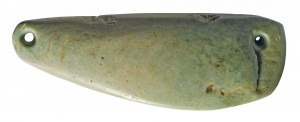 Who knows whose neck the exotic jadeite amulet adorned? To reach the Maltese shores, this item travelled a very long distance in prehistoric times. Therefore, it must have been really treasured, raising the status of its owner. It is difficult to see a symbolic meaning in such an amulet, however, it was chosen to accompany an individual who was laid to rest at the Xagħra Circle in Gozo.
Who knows whose neck the exotic jadeite amulet adorned? To reach the Maltese shores, this item travelled a very long distance in prehistoric times. Therefore, it must have been really treasured, raising the status of its owner. It is difficult to see a symbolic meaning in such an amulet, however, it was chosen to accompany an individual who was laid to rest at the Xagħra Circle in Gozo.We all know that person who would throw nothing away, and keeps mending an object till the very last. Well, it seems that such persons have existed since prehistoric times. A jar which was unearthed at Skorba Temples was drilled with pairs of holes above and below the crack to tie the two parts together with a long string. Who could tell whether these interventions served their purpose?
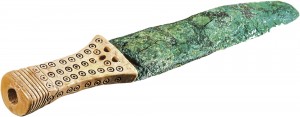 To whom did the elegant bone and copper dagger, that was discovered at Għar Mirdum in Dingli Cliffs, belong? Clearly designed for prestige rather than for defence, such a lovely object is unlikely to have been casually lost. So why was it left in this buried cave?
To whom did the elegant bone and copper dagger, that was discovered at Għar Mirdum in Dingli Cliffs, belong? Clearly designed for prestige rather than for defence, such a lovely object is unlikely to have been casually lost. So why was it left in this buried cave?Was the heavily pregnant female clay figure which was found at the Tarxien Temples, pierced in sixteen places with sharp fragments of shell, really intended to curse an opponent by magical means? And did the magic spell work?
While the first clay figure of the Sleeping Lady that was found in the Hypogeum of Ħal Saflieni rested on its side, another one discovered at the same site, lies face down with her breasts hidden beneath her. If either or both these figures could come to life, they would tell us a great deal about what we should dearly like to know about themselves and their times, though we might have great difficulty in understanding what they had to say. What would it take to wake them up?
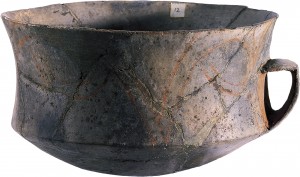 Archaeological discoveries are not only made in main sites. Nearby locations could be as significant for further revelations. The remains of a carinated clay offering bowl was recovered during investigations in the North Cave at the megalithic site of Ġgantija. Decorated with coloured scratched volutes, this bowl must have been considered sacred enough so as not to be casually scattered. It would be so intriguing to know in which rituals it was used.
Archaeological discoveries are not only made in main sites. Nearby locations could be as significant for further revelations. The remains of a carinated clay offering bowl was recovered during investigations in the North Cave at the megalithic site of Ġgantija. Decorated with coloured scratched volutes, this bowl must have been considered sacred enough so as not to be casually scattered. It would be so intriguing to know in which rituals it was used.These are only a few of the engaging narratives which form part of the collection of fifty artefacts in Heritage Malta’s latest publication “Malta’s Prehistoric Treasures”.
Skillfully chosen from the National Collection by the renowned late archaeologist Dr. David Trump, the artefacts are intended to accompany the readers along a personal journey in Maltese prehistory which fascinated him so much.
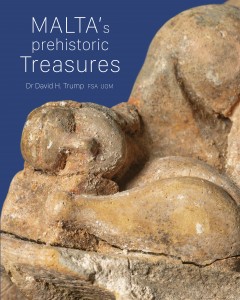 This makes the book even more significant since the selected artefacts are not only allowing the readers to learn about the local prehistoric people but also to see through the eyes of a very inspirational archaeologist.
This makes the book even more significant since the selected artefacts are not only allowing the readers to learn about the local prehistoric people but also to see through the eyes of a very inspirational archaeologist.The book has an additional narrative by Heritage Malta Senior Curator, Sharon Sultana.
Photography and design by Daniel Cilia.
Malta’s Prehistoric Treasures is available from Heritage Malta sites and museums.
For more information, visit www.heritagemalta.org
(This feature was published in The Times of Malta issued on 30th December 2019)
-
Free weekly acupuncture treatments in Gozo
Since 1994, several Chinese medical teams have been offering medical treatments to the Maltese public from the Mediterranean Regional Centre for Traditional Chinese Medicine in Kordin. This professional service extends also at Mater Dei Hospital and at Gozo General Hospital.
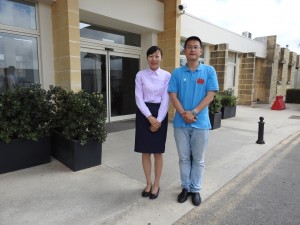 I accompanied Dr Xiao Ming Yang and Ms Wei Han on their weekly visit to Gozo General Hospital.
I accompanied Dr Xiao Ming Yang and Ms Wei Han on their weekly visit to Gozo General Hospital.“Every Wednesday afternoon, I treat an average of 24 patients with acupuncture. Many of the patients book the treatment at the hospital, however I do not mind treating also those individuals who happen to come by,” explained Dr Yang.
Dr Yang and Ms Han’s dedication to their work is impeccable. They take the responsibility to carry with them all the required material from Malta to Gozo. From time to time, they also provide the patients with bonus treatments to take home with them.
“Acupuncture treatments are provided free of charge according to an agreement which was done between the Maltese and the Chinese governments. This is a way of showing the mutual respect which exists between the two countries.”
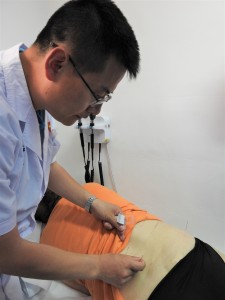 Around 30 patients were waiting for Dr Yang at Gozo General Hospital. The relationship between the Chinese doctor and his Gozitan patients was clearly amicable as he went round each patient and applied the required acupuncture treatment.
Around 30 patients were waiting for Dr Yang at Gozo General Hospital. The relationship between the Chinese doctor and his Gozitan patients was clearly amicable as he went round each patient and applied the required acupuncture treatment.The popularity of this treatment is definitely pushing for more adequate space in order to provide this service to all those who need it. For a more effective benefit of this Chinese traditional therapy, several patients have also expressed their wish to increase the frequency of the doctor’s visit to at least twice a week.
After the acupuncture treatment, Ms Han, the Chinese interpreter at the Centre, prepared five different herbal teasfor those who attended. She also shared interesting information about the benefits of these teas.
“Chinese herbal teas have been used for centuries to provide healthy refreshment. Drinking herbal teas is a natural and effective way to gain various health benefits. Each tea can have one ingredient or many with different benefits,” revealed Ms Han.
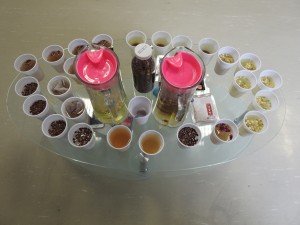 “Jasmine tea is one of the most popular flower teas among foreigners because of its pleasant scent and taste. In ancient times in China, this tea was mainly reserved for royalty since it has so many health benefits. The high level of antioxidants in the tea help to boost the body metabolism making exercise more effective. This may result in weight loss and in improvement in the digestive process. Moreover, for those with cardiovascular problems, jasmine tea can be a huge help as it aids to lower cholesterol levels and high blood pressure, thereby reducing the risk of heart attacks and maintaining a healthy cardiovascular system. This tea is also ideal for people suffering from chronic discomfort, such as back pain, joint pain and arthritis, because it has anti-inflammatory properties which can help reduce swelling and inflammation of joints.”
“Jasmine tea is one of the most popular flower teas among foreigners because of its pleasant scent and taste. In ancient times in China, this tea was mainly reserved for royalty since it has so many health benefits. The high level of antioxidants in the tea help to boost the body metabolism making exercise more effective. This may result in weight loss and in improvement in the digestive process. Moreover, for those with cardiovascular problems, jasmine tea can be a huge help as it aids to lower cholesterol levels and high blood pressure, thereby reducing the risk of heart attacks and maintaining a healthy cardiovascular system. This tea is also ideal for people suffering from chronic discomfort, such as back pain, joint pain and arthritis, because it has anti-inflammatory properties which can help reduce swelling and inflammation of joints.”“Rose tea is used to relieve menstrual discomfort or heavy period. It can also regulate the sleep cycle and pattern. For those who suffer from insomnia or have disturbed sleep, drinking rose tea before going to bed might be a great option. Rose tea can also improve digestion, detoxify the body, and relieve respiratory infections.”
 “Buckwheat tea is a kind of grain tea and it can reduce blood glucose and cholesterol. It really has significant cardiovascular benefits and helps to lose weight.”
“Buckwheat tea is a kind of grain tea and it can reduce blood glucose and cholesterol. It really has significant cardiovascular benefits and helps to lose weight.”“Rhodiola tea is made of dry flowers, leaves and roots of a wild plant called Rhodiola Rosea, which grows best in the high, cold mountains, such as Tibet, Siberia and Arctic areas.It has good effects on anti-aging and longevity.In ancient times, Chinese emperors used to send expeditions to remote areasin search of this golden root to make pills of immortality. This tea can also protect human cells especially skin cells from aging, so a lot of beauty products use it as one of their ingredients.”
“Jujube is a kind of sour date. Thanks to its special healing properties relating to insomnia, it is regarded as the “Oriental sleeping fruit.”Jujube seed tea can calm the mind and smooth the nerves. Therefore, it is often used to treat insomnia, nightmares, night sweats, restless sleep and neurasthenia.”
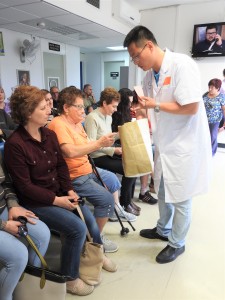 At the end of this meeting, participants were also provided with a packet of tiger balm, green oil and plasters. Tiger balm has been in use in China from the 1870s and it serves to relieve back pain, joint pain, stiffness, sprains, arthritis, headaches, sinus congestion, and discomfort from mosquito bites. Green oil has the same effect as tiger balm. Plasters are mainly used to relieve back pains, joint pains, arthritis, chronic sprain, and rheumatism.
At the end of this meeting, participants were also provided with a packet of tiger balm, green oil and plasters. Tiger balm has been in use in China from the 1870s and it serves to relieve back pain, joint pain, stiffness, sprains, arthritis, headaches, sinus congestion, and discomfort from mosquito bites. Green oil has the same effect as tiger balm. Plasters are mainly used to relieve back pains, joint pains, arthritis, chronic sprain, and rheumatism.For more information, one can contact the Mediterranean Regional Centre for Traditional Chinese Medicine in Kordin on 2169 1799 or the Gozo General Hospital on 2210 6000.
(This article was published in The Malta Independent on Sunday on 5 June 2018)
-
A THIRST FOR KNOWLEDGE
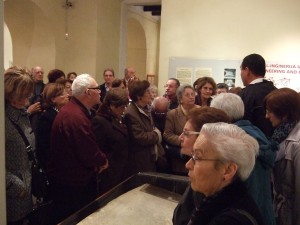 It is never too late to learn something new. Evidence of the benefits of lifelong learning is overwhelming. Feeling connected to life and to others, being eager and motivated to explore different themes, keeping active intellectually, socially and physically are just some of the rewarding factors.
It is never too late to learn something new. Evidence of the benefits of lifelong learning is overwhelming. Feeling connected to life and to others, being eager and motivated to explore different themes, keeping active intellectually, socially and physically are just some of the rewarding factors.Martin Diacono has been attending to lectures at the University of the Third Age for the past 10 years.
“It is mostly my thirst for knowledge which urges me to follow these lectures. I even attend to the lectures which are offered to the general public by the University of Malta. I have a deep interest in art and these lectures provide me with the opportunity to acquire more information about this subject and to involve myself in related study tours abroad,” explains Diacono.
The University of the Third Age which is also known as U3A was launched in Malta on 23 January 1993 under the auspices of the University of Malta.
 “The main aim of U3A is to promote a yearning for knowledge and creativity. Although the lectures are held at university, their purpose is different from those which are intended to coach students to obtain academic qualifications and find a job. There are no admission requirements and anyone above the age of sixty may apply, irrespective of the level of education. There are no assignments to work on and no exams to sit for. Lectures are there for the sheer pleasure of learning new things in the company of a group of people who nourish similar interests. The cost for the lectures covering from October to June is 12 euros.”
“The main aim of U3A is to promote a yearning for knowledge and creativity. Although the lectures are held at university, their purpose is different from those which are intended to coach students to obtain academic qualifications and find a job. There are no admission requirements and anyone above the age of sixty may apply, irrespective of the level of education. There are no assignments to work on and no exams to sit for. Lectures are there for the sheer pleasure of learning new things in the company of a group of people who nourish similar interests. The cost for the lectures covering from October to June is 12 euros.”U3A operates from four centres; three in Malta and one in Gozo.
“The head centre is at the Catholic Institute in Floriana. Lectures are held from Monday to Thursday from 09:00am to 11:00am. The Sliema Centre is at the Salesian School of St. Patrick’s. Lectures are held from Tuesday to Thursday from 05:00pm to 7:00pm. The Cottonera Resource Centre is located in St Edwards Street, Vittoriosa (Birgu). Lectures are held every Thursday from 09:00am to 11:00am. The one in Gozo is at the Day Centre of Għajnsielem. Lectures are held every Friday from 09:00am to 11:00am.”
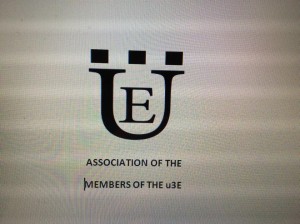 Shortly after the launching of the University of the Third Age, its first members felt the need to establish a Foundation in order to organize a number of social activities together.
Shortly after the launching of the University of the Third Age, its first members felt the need to establish a Foundation in order to organize a number of social activities together.“This Foundation eventually turned into a formal Association which was named the Association of the Members of the U3E. A statute was set up to define it and a Commitee was elected democratically. The Commitee has a term of two years, after which an election is held to form a new one.”
“The Association’s objectives are to promote and safeguard the aims and activities of the U3E, to establish a point of social contact and support to its members, and to organize extra-curriculum activities for its members. Moreover, the Association is responsible for the publishing of a quarterly newsletter and for the organisation of a biennial conference on third age learning.”
Membership in the Association is only open to U3A members. The membership fee is 3 euros annually, however members will be asked to pay a nominal fee if they wish to attend to the activities which are organized by the Association.
Since most lectures are held from Mondays to Thurdays, social activities take place on the first and third Fridays of each month.
“On the first Friday of each month we attend to a mass followed by lunch. Each month we go to a different parish in order to give the opportunity to our members to visit various parishes. Lunch will be booked in a restaurant which is close to the particular area selected in that month.”
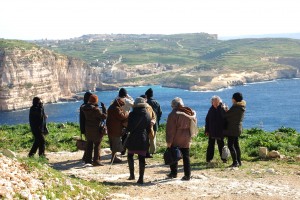 “The third Friday of each month is dedicated to a cultural tour, again followed by lunch. The excursions generally consist of visits to sites of historical and cultural interest, both in Malta and Gozo. Guides accompany the members during such visits so that they can appreciate the full value of each place. Some of the places which we have visited in Valletta are St John’s Co-Cathedral, the Archaeological Museum, the War Museum and St Elmo, the Fine Arts Museum and Casa Rocca Piccola. Other sites include the Mdina Cathedral and its Museum, and Wignacourt Museum in Rabat, Malta.”
“The third Friday of each month is dedicated to a cultural tour, again followed by lunch. The excursions generally consist of visits to sites of historical and cultural interest, both in Malta and Gozo. Guides accompany the members during such visits so that they can appreciate the full value of each place. Some of the places which we have visited in Valletta are St John’s Co-Cathedral, the Archaeological Museum, the War Museum and St Elmo, the Fine Arts Museum and Casa Rocca Piccola. Other sites include the Mdina Cathedral and its Museum, and Wignacourt Museum in Rabat, Malta.”“From Mondays to Thursdays, further activities are also organized throughout the academic year right after the lectures end. Fitness classes held by qualified persons take place from Mondays to Wednesdays and these consist of Keep Fit, Line Dancing and Ballroom Dancing. On Thursdays, members of the Association’s choir attend to rehearsals under the leadership of Dame Marie Therese Vassallo. This choir performs in the mass which is held on the first Friday of each month, at various care homes for elder persons, and also at the national event of the Active Ageing Awards.”
 “Annual milestones for our Association are the Christmas buffet lunch, the Malta round trip boat cruise, and tours abroad. In 2015 and 2016 we organized a day trip to Sicily where we visited different places of interest. In 2017 we went for a five-day tour to Sicily where we visited Palermo and its surroundings. This year we intend to take our members to a five-day trip to Paris.”
“Annual milestones for our Association are the Christmas buffet lunch, the Malta round trip boat cruise, and tours abroad. In 2015 and 2016 we organized a day trip to Sicily where we visited different places of interest. In 2017 we went for a five-day tour to Sicily where we visited Palermo and its surroundings. This year we intend to take our members to a five-day trip to Paris.”For the past 4 years, Mr Diacono was elected as the President of the Association of the Members of the U3E.
“It is a privilege to be able to form part of the Committee of this Association which provides so much opportunity to elders to enrich their quality of life and their social development. From 1993 to 2017, this Association has worked very closely with Prof. Joseph Troisi who was the Director of the University of the Third Age. Since his retirement, we are now looking forward to establish a strong relationship with Prof. Marvin Formosa who is the new Director.”
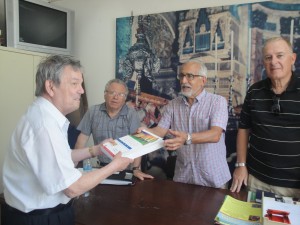 Applications from persons who are interested to attend lectures at any of the Centres of the University of the Third Age, and to join the Association of the Members of the U3E open in September. However, one can also register throughout the academic year. Lectures cover a wide range of topics and each module consists of eight lectures. Between February and June 2018, the following modules will commence at:
Applications from persons who are interested to attend lectures at any of the Centres of the University of the Third Age, and to join the Association of the Members of the U3E open in September. However, one can also register throughout the academic year. Lectures cover a wide range of topics and each module consists of eight lectures. Between February and June 2018, the following modules will commence at:The Floriana Centre: Malta Marittima by Dr. Timmy Gambin, The British Period in Malta by Richard P Agius, Government systems in Malta and abroad by Lawrence Grech, Il-Folklor Malti bħala parti mill-wirt kulturali (Tieni Parti) by Marlene Mifsud Chircop, Interpretative Perspectives of Maltese History in Constructing National Identity by Dr Charles Xuereb, Voices of U3A members (sharing experiences), Għerf Missirijietna: riflessjonijiet filosofiċi fuq il-proverbji Maltin by Prof. Joe Friggieri, and Looking into art: How to discuss works of art from different standpoints by Dr. Christian Attard.
The Sliema Centre: The Constitution of Malta by Prof. Kevin Aquilina, The Medieval Millennium by Vincent Zammit, Historical, Literary and Theological aspects of the Bible by Rev. Dr. Stefan Attard, and Understanding Dementia by Dr. Anthony Scerri.
The Cottonera Centre: Malta During the 19th Century by Vincent Zammit, and Ħajti tiegħi – nagħżel jien! by Marica Mizzi.
The Gozo Centre: L-Iżvilupp tal-Edukazzjoni f’Malta by Joseph Xerri, and Ġrajjiet Malta u Għawdex: Storja u Letteratura by Kav. Joe M Attard.
For more information, one can contact the U3E head office at the Catholic Institute in Floriana on 2124 3202 or by email at diacstef@onvol.net .
(This article was published in the Senior Times – January Issue issued with The Times of Malta on the 18th January 2018)
-
Guests to history
One would probably spare only a few moments of consideration at the receipt of a wedding invitation. However, for Baron Igino de Piro d’Amico Inguanez, these endearing solicitations were cherished so much that he kept a collection of them, neatly separated according to their date and wrapped up together by a string.
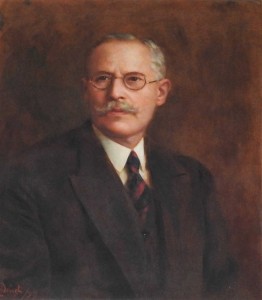 “Were it not for my grandfather’s interest to keep these wedding invitations, we would have lost this fascinating information which can be unravelled within each one of them,” remarked Marquis Nicholas de Piro as we walked towards an elegant table in one of the rooms at Casa Rocca Piccola where he had layed out a number of these invitations.
“Were it not for my grandfather’s interest to keep these wedding invitations, we would have lost this fascinating information which can be unravelled within each one of them,” remarked Marquis Nicholas de Piro as we walked towards an elegant table in one of the rooms at Casa Rocca Piccola where he had layed out a number of these invitations.I glanced out at the wide selection of wedding invitations tastefully set on the polished wooden surface, noticing the different sizes, shapes, writing, designs and paper. The earliest ones dated back to 1815, 1829 and 1832. They were quite plain and small, slightly bigger than a credit card, and written in Italian.
“Here are two of the prettiest ones” said the Marquis as he pulled them out of the rest.
These two invitations had been issued at the end of the 19th century. They were larger than the earlier ones and were quite different from each other. The one dated June 1896 was elegantly designed with an intricate cross at its corner and consisted of an invitation to the wedding between the noble Maria de Piro and Dr. Alfredo Stilon. The other one dated October 1899 was more colourful and rather than an invitation, it was more an announcement of the wedding which was to take place between the noble Maria Teresa de Piro and the Marquis Paolo Apap Bologna. Once again, both were written in Italian.
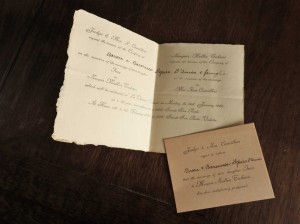 “Now look at this note which accompanies this wedding invitation,” said the Marquis as he handed it to me.
“Now look at this note which accompanies this wedding invitation,” said the Marquis as he handed it to me.The presentation of this wedding invitation was simpler than the previous two and the writing was in English. Here, Judge and Mrs L Camilleri were requesting the company of Baron and Baroness I de Piro d’Amico Inguanez and family to the wedding of their noble daughter Inez to Marquis Mallia Tabone on 26th January 1920. Yet this celebration was not destined to take place as a smaller card which was sent some days later informed those invited that this wedding had been indefinitely postponed.
 “From these invitations, one can also observe the traditional customs of the various eras. For example, this wedding invitation dated 1935 shows clearly that people who chose to get married during the period of Lent had to abide to some limitations.”
“From these invitations, one can also observe the traditional customs of the various eras. For example, this wedding invitation dated 1935 shows clearly that people who chose to get married during the period of Lent had to abide to some limitations.”Indeed, a formal note which was inserted together with the wedding invitation that was sent by Chev & Mrs E Moore and Mrs H Xuereb to announce the marriage of their daughter Alice Moore to Godfrey Xuereb, provided this information with direct instructions:
‘It is much regretted that in view of the restrictions imposed by Canon Law for weddings held in Lent, only a few guests may attend the religious ceremony at the Archbishop’s Palace.
You are therefore invited to meet the bride and bridegroom immediately after the ceremony at the residence at 4:00pm.’
 As we followed the different invitations that were sent along the years to Baron Igino and his family, we could also trace some of his friends and acquaintances, their residences, the chapels and churches where the marriages took place, and the selected locations for the wedding receptions. Although many of the churches still exist today, some of the street names had changed from Italian to English or were altered completely. A number of the residences mentioned have become quite renowned today whilst a few others were turned into commercial properties. Sadly, some of the lovely villas which provided exquisite entertainment in the bygone days were demolished to make place for large modern complexes.
As we followed the different invitations that were sent along the years to Baron Igino and his family, we could also trace some of his friends and acquaintances, their residences, the chapels and churches where the marriages took place, and the selected locations for the wedding receptions. Although many of the churches still exist today, some of the street names had changed from Italian to English or were altered completely. A number of the residences mentioned have become quite renowned today whilst a few others were turned into commercial properties. Sadly, some of the lovely villas which provided exquisite entertainment in the bygone days were demolished to make place for large modern complexes.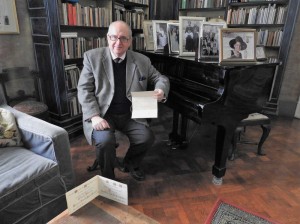 Amongst these, there was the wedding between Hilda Scicluna and Paymaster Lieutenant W Eric Brockman that took place on 4th March 1928. Their marriage was celebrated at the Archbishop’s Palace in Valletta which seems to have been quite a popular venue for such occasions. On the other hand, the reception was held at the bride’s parents residence that was located at 86 Strada Merkanti Valletta; a house which originally belonged to Sir Oliver Starkey, Bali of Aquila and Latin Secretary to Grand Master La Valette. Being an English Knight, he had assisted the Grand Master during the Great Siege of 1565 and was later given the privilege to be buried in the crypt of the Co-Cathedral of St John in Valletta, close to La Valette’s own burial place.
Amongst these, there was the wedding between Hilda Scicluna and Paymaster Lieutenant W Eric Brockman that took place on 4th March 1928. Their marriage was celebrated at the Archbishop’s Palace in Valletta which seems to have been quite a popular venue for such occasions. On the other hand, the reception was held at the bride’s parents residence that was located at 86 Strada Merkanti Valletta; a house which originally belonged to Sir Oliver Starkey, Bali of Aquila and Latin Secretary to Grand Master La Valette. Being an English Knight, he had assisted the Grand Master during the Great Siege of 1565 and was later given the privilege to be buried in the crypt of the Co-Cathedral of St John in Valletta, close to La Valette’s own burial place.The Cathedral in Mdina seems to have been another prominent place for marriages. On 24th January 1937, Adelina Maempel was married to Edwin England Sant Fournier. A reception followed at Villa Luginsland in 26 Boschetto Road, Rabat; a lovely villa which was built by Baron Max von Tucker, the German consul who was serving in Malta in the early 20th century. Unfortunately in recent years years, this remarkable place was in an abandoned state and had a haunting atmosphere.
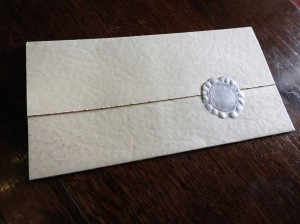 The only wedding invitation which came from Gozo looked quite distinguished and it boasted a silver wax seal. The marriage of Carmela and Paul Vella took place on 4th August 1937 and their reception was organized at the Duke of Ediburgh Hotel in Victoria, Gozo. Alas, in recent years, this splendid hotel that was beautifully constructed in Victorian architecture was demolished in order to make way for a commercial centre and a number of residential units.
The only wedding invitation which came from Gozo looked quite distinguished and it boasted a silver wax seal. The marriage of Carmela and Paul Vella took place on 4th August 1937 and their reception was organized at the Duke of Ediburgh Hotel in Victoria, Gozo. Alas, in recent years, this splendid hotel that was beautifully constructed in Victorian architecture was demolished in order to make way for a commercial centre and a number of residential units.“As you have already noted, some of these wedding invitations pertained to our relatives. Incidentally, this one which announces the marriage between my aunt Mona de Piro to Major John E J Nelson on 28th December 1940 is a favourite of mine, particularly because she was quite a character and she kept her high spirits even when she was aged more than ninety. Well, she’s there, looking at us!” the Marquis exclaimed as he pointed to a delightful portrait on the opposite wall.
My eyes met with those of a young, graceful girl, defiantly posing with an off-the-shoulder silver dress which melted in the greyish background behind her.
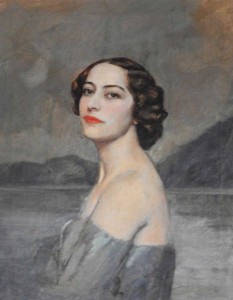 “That portrait created much talk when her relatives saw it since it was regarded too sensual at the time. It was commissioned by her Italian boyfriend, Marquis Onofrio Bartolini Salinbeni, and the painting was done by Arthur Acton who lived in a palace in Florence. Onofrio was madly in love with Mona but unfortunately, their relationship ended and when she returned to Malta, a relative of hers went to Italy to claim this painting since it was not deemed fit for him to keep it,” smiled the Marquis as he went to add some logs to the fire burning in the stylish hearth besides us.
“That portrait created much talk when her relatives saw it since it was regarded too sensual at the time. It was commissioned by her Italian boyfriend, Marquis Onofrio Bartolini Salinbeni, and the painting was done by Arthur Acton who lived in a palace in Florence. Onofrio was madly in love with Mona but unfortunately, their relationship ended and when she returned to Malta, a relative of hers went to Italy to claim this painting since it was not deemed fit for him to keep it,” smiled the Marquis as he went to add some logs to the fire burning in the stylish hearth besides us.A warm gush of air embraced the room as the logs protested and cracked and poured a glowing light over the wedding invitations lying in front of us. For a short spell, I thought that I could hear the tinkling of the glasses filled with red velvety wine and golden sizzling champagne as the guests toasted to the newly married couples.
(This article was published in the Weddings Supplement issued with The Sunday Times of Malta dated 13th March 2016)
Travelogue
Archives
| M | T | W | T | F | S | S |
|---|---|---|---|---|---|---|
| « Jan | ||||||
| 1 | 2 | 3 | 4 | 5 | 6 | 7 |
| 8 | 9 | 10 | 11 | 12 | 13 | 14 |
| 15 | 16 | 17 | 18 | 19 | 20 | 21 |
| 22 | 23 | 24 | 25 | 26 | 27 | 28 |
| 29 | 30 | |||||
Recent Posts
- A MATTER OF FATE
- MALTA’S PREHISTORIC TREASURES
- THE MAGIC IS IN THE DETAIL
- THE SELLING GAME
- NEVER FORGOTTEN
- Ġrajjiet mhux mitmuma – 35 sena mit-Traġedja tal-Patrol Boat C23
- AN UNEXPECTED VISIT
- THE SISTERS OF THE CRIB
Comments
- Pauline Harkins on Novella – Li kieku stajt!
- admin on IL-KARNIVAL TRAĠIKU TAL-1823
- Albert on IL-KARNIVAL TRAĠIKU TAL-1823
- Martin Ratcliffe on Love in the time of war
- admin on 24 SENA ILU: IT-TRAĠEDJA TAL-PATROL BOAT C23